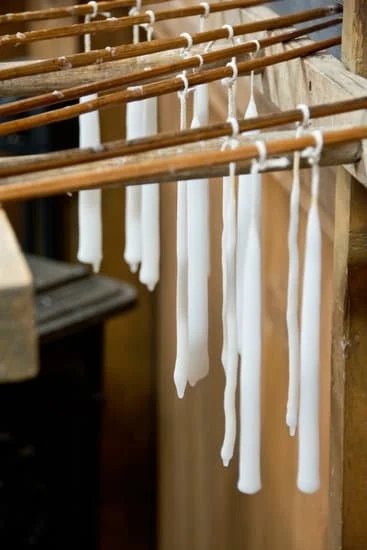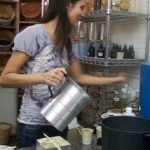Embarking on a journey into the world of candle making can be both exciting and rewarding. To ensure your venture is met with success, it is essential to have a well-thought-out candle making success plan in place. This plan will serve as a roadmap, guiding you through the process of creating beautiful and unique candles that stand out in the market.
Whether you are a beginner looking to explore the art of candle making or an experienced crafter seeking to enhance your skills, this article will delve into the key components of a successful candle making journey. From understanding the basics of materials and tools needed to selecting the right wax and wick for your candles, each step plays a crucial role in achieving your desired outcomes.
As we dive deeper into topics such as exploring different candle making techniques, scent selection and mixing, design and packaging tips, marketing strategies, and troubleshooting common issues, you will gain valuable insights that will set you on the path to candle making success. By crafting a solid success plan including setting goals and tracking progress, you can elevate your candle creations to new heights while enjoying the creative process along the way.
Understanding the Basics of Candle Making
When diving into the world of candle making, it is essential to have a solid understanding of the basic materials and tools needed for this craft. The key components for making candles include wax, wicks, fragrance oils, colorants, containers, a heat source, a thermometer, and a stirring utensil. Each of these elements plays a crucial role in creating high-quality candles that burn well and look visually appealing.
Wax is the foundation of any candle, and there are various types to choose from such as paraffin, soy, beeswax, or palm wax. Different waxes have unique characteristics that can impact the final product’s appearance and burn time.
Wicks come in different sizes and materials like cotton or wood, affecting how the candle burns and releases fragrance. Additionally, fragrance oils and colorants allow you to customize your candles with scents that appeal to your target market and colors that match your brand aesthetic.
In terms of tools, a double boiler or microwave-safe container for melting wax safely is essential. A thermometer helps monitor the wax temperature to prevent overheating or under-heating. Stirring utensils like wooden sticks or stainless steel spoons are necessary for blending fragrance oils or colorants into the melted wax evenly. By familiarizing yourself with these basic materials and tools, you can lay a strong foundation for your candle making success plan.
| Materials | Tools |
|---|---|
| Wax | Double boiler |
| Wicks | Thermometer |
| Fragrance oils | Stirring utensil |
Selecting the Right Wax and Wick for Your Candles
When it comes to candle making, selecting the right wax and wick are crucial components that can greatly impact the final product. The type of wax used will determine the burn time, scent throw, color vibrancy, and overall quality of the candle.
There are various types of waxes available in the market, such as paraffin, soy, beeswax, and palm wax. Each type has its own unique characteristics and benefits, so it’s important to choose one that aligns with your preferences and goals for your candles.
In addition to selecting the right wax, choosing the appropriate wick is equally important in achieving a successful candle making outcome. Wicks come in different sizes, materials, and shapes, each designed for specific types of candles.
Factors to consider when selecting a wick include the diameter of the container or mold you’re using, the type of wax being used, desired burn time, and fragrance load. A wick that is too small may result in tunnelling (when a hole forms in the center of the candle), while a wick that is too large can cause excess smoke and uneven burning.
Finding the perfect combination of wax and wick for your candles requires experimentation and testing. Keep detailed records of your experiments by noting which combinations worked well and which ones did not meet your expectations. By keeping track of these results, you can refine your candle making process over time and create a successful candle making success plan tailored to your unique preferences and goals.
| Wax Type | Key Characteristics |
|---|---|
| Paraffin | Most commonly used; good scent throw; vibrant colors |
| Soy | Natural alternative; clean-burning; eco-friendly |
| Beeswax | Naturally aromatic; longer burn time; premium quality |
| Palm Wax | Firm texture; beautiful crystalline finish; sustainable option |
Exploring Different Candle Making Techniques
When it comes to candle making, there are a variety of techniques that can be used to create beautiful and unique candles. Whether you are just starting out as a beginner or have some experience in candle making, understanding different techniques can help you take your craft to the next level. Here are some popular candle making techniques to explore:
- Container Candles: One of the most common and beginner-friendly techniques is making container candles. This involves pouring melted wax into a container with a wick, allowing the candle to take shape as it cools.
- Pillar Candles: Pillar candles are freestanding candles that are molded or hand-poured without the use of a container. This technique requires more precision and skill to achieve smooth, evenly burning candles.
- Rolled Candles: Rolled candles involve rolling sheets of beeswax or paraffin around a wick to create colorful and decorative tapered candles. This technique is great for those looking for a creative candle making project.
Exploring different candle making techniques not only allows you to create diverse types of candles but also helps you develop new skills and knowledge in the craft. As you progress from basic techniques to more advanced ones, you will find yourself expanding your creativity and pushing the boundaries of what is possible with candle making.
- Gel Candles: Gel candles are made using transparent gel wax that allows for embedding objects like seashells or glass beads for unique designs. This technique provides endless possibilities for creating visually stunning candles.
- Soy Wax Melts: Soy wax melts are becoming increasingly popular due to their ease of use and clean-burning nature. This technique involves melting soy wax and adding fragrance oil before pouring it into molds to create scented melts for wax warmers.
Remember, each candle making technique has its own set of requirements and challenges, so don’t be afraid to experiment and try new things until you find what works best for you. By exploring different techniques, you can broaden your skills, enhance your creativity, and ultimately pave the way towards achieving your candle making success plan.
Scent Selection and Mixing
Choosing the Right Scents
When choosing scents for your candles, it’s essential to understand the fragrance notes and how they interact with each other. Consider popular scent categories like floral, fruity, citrusy, woodsy, or musky when selecting fragrances. Additionally, think about the intensity of the scent and how it will disperse when the candle is burned. It’s also important to test different scents to ensure they perform well in your chosen wax.
Creating Custom Blends
One way to make your candles stand out is by creating custom scent blends that reflect your unique style and brand identity. Experiment with blending different essential oils or fragrance oils to develop signature scents for your candles. Keep track of the ratios used for each blend so you can replicate successful combinations in the future. Engage with your customers to gather feedback on new scents and adjust your creations based on their preferences.
Incorporating captivating scents into your candle making process not only enhances the product but also helps build a loyal customer base. By focusing on scent selection and mixing as part of your candle making success plan, you can create candles that leave a lasting impression and keep customers coming back for more. Remember to stay creative, experiment with new combinations, and always strive for perfection in every fragrance you create.
Design and Packaging Tips
Design and packaging play a crucial role in making your handmade candles stand out in a competitive market. With the right visual appeal, you can attract more customers and leave a lasting impression. Here are some design and packaging tips to help you elevate your candle making business:
Branding Your Candles
Creating a recognizable brand for your candles is essential for building customer loyalty. Consider designing a unique logo or label that represents your brand identity. Choose colors, fonts, and imagery that reflect the style and vibe of your candles. Consistent branding across all your products will help consumers easily identify your candles amidst the sea of options available.
Creative Container Choices
The container in which your candle sits can greatly impact its overall look and feel. Explore different container options such as jars, tins, or even vintage teacups to add personality to your candles. Make sure the containers are not only visually appealing but also functional and safe for burning candles. Experiment with various shapes, sizes, and materials to find what works best for your candle line.
Unique Packaging Elements
Think beyond just the candle itself when it comes to packaging. Consider adding special touches like ribbon bows, custom tags, or eco-friendly wrapping to enhance the unboxing experience for customers. Personalized notes or care instructions can make the recipient feel truly special when they receive their candle. Paying attention to these small details can set your candles apart from mass-produced alternatives on the market.
By investing time and effort into designing captivating labels, selecting appealing containers, and adding thoughtful packaging elements, you can make your handmade candles truly stand out. Remember that every aspect of design and packaging should align with your brand image and target audience preferences to create a cohesive visual identity for your candle making success plan.
Marketing and Selling Your Handmade Candles
When it comes to marketing and selling your handmade candles, having a solid strategy in place is essential to achieving success. With the right approach, you can not only attract customers to purchase your products but also build a loyal following for your brand. Here are some key strategies to consider when it comes to marketing and selling your candles:
- Identify Your Target Market: Understanding who your target customers are is crucial in developing effective marketing campaigns. Consider factors such as age, interests, and buying behavior to tailor your messaging accordingly.
- Create a Strong Brand Identity: Establishing a unique and memorable brand identity will help differentiate your candles from competitors. This includes designing a logo, choosing a color scheme, and crafting a compelling brand story that resonates with customers.
- Utilize Social Media: Social media platforms like Instagram, Facebook, and Pinterest can be powerful tools for showcasing your products and connecting with potential customers. Regularly post visually appealing content, engage with followers, and use targeted ads to reach a wider audience.
In addition to these strategies, networking with other small business owners in the industry can help you gain valuable insights and potentially collaborate on marketing efforts. By continuously refining your marketing approach based on feedback and data analysis, you can effectively promote and sell your handmade candles while building a strong customer base.
Remember that consistency is key when it comes to marketing and selling handmade candles. By developing a clear plan that outlines specific goals and action steps – such as increasing online sales by 20% within six months or expanding into new retail locations – you can track progress towards achieving success in your candle making business.
With dedication, creativity, and strategic planning, you can turn your passion for candle making into a thriving venture that resonates with customers seeking unique and high-quality products.
Troubleshooting Common Candle Making Issues
One common issue that many candle makers face is tunneling, where the wax burns down the center of the candle, leaving excess wax around the sides. To prevent tunneling, it’s crucial to choose the right wick size for your candle diameter and type of wax. Ensuring that you trim the wick to the appropriate length before each use can also help promote a more even burn and prevent tunneling.
Another prevalent problem in candle making is frosting, which appears as white patches on the surface of the candle. Frosting occurs when the wax cools too quickly or is exposed to temperature fluctuations during cooling. To minimize frosting, try creating a more gradual cooling environment by allowing your candles to cool at room temperature or using a heat gun to gently warm the surface and smooth out those white patches.
Additionally, problems with fragrance throw can be frustrating for candle makers who want their creations to emit a strong and lasting scent. Issues such as overheating the fragrance oil or using too much fragrance can affect how well your candles smell when burned.
To improve fragrance throw, experiment with different scent concentrations and curing times to find the optimal balance for achieving a pleasing aroma without overwhelming scent throw. By troubleshooting these common candle making issues proactively, you can enhance the quality of your candles and ultimately achieve success in your craft.
Crafting a Candle Making Success Plan
Crafting a successful candle making business involves more than just creating beautiful candles. It requires strategic planning, goal-setting, and tracking progress to ensure long-term success. Developing a candle making success plan is essential in guiding your business towards growth and profitability.
One key aspect of crafting a candle making success plan is setting specific, measurable, achievable, relevant, and time-bound (SMART) goals. This allows you to have clear objectives to work towards and helps keep you focused on your priorities. Whether it’s increasing production output, expanding your product line, or reaching a certain sales target, having defined goals can give you a roadmap to follow.
In addition to setting goals, tracking your progress is crucial in evaluating the effectiveness of your candle making business strategies. Monitoring key performance indicators (KPIs) such as sales revenue, production costs, customer satisfaction, and market trends can provide valuable insights into what is working well and where improvements are needed.
By regularly reviewing these metrics, you can make informed decisions to optimize your operations and drive business growth. Ultimately, crafting a candle making success plan involves continuously adapting and refining your approach based on the data and feedback you receive.
Conclusion
In conclusion, embarking on the journey towards candle making success requires a well-thought-out plan that encompasses all the essential elements discussed in this comprehensive guide. By understanding the basics of candle making, selecting the right materials, exploring various techniques, and honing your scent mixing skills, you are laying a solid foundation for success in this craft.
Additionally, paying attention to design and packaging tips will help differentiate your candles in a competitive market, while implementing effective marketing strategies will ensure your creations reach their intended audience.
Crafting a candle making success plan involves setting specific goals, tracking progress, and continuously improving your skills and techniques. It is important to stay curious, experiment with new ideas, and remain open to learning from both successes and challenges along the way. Remember that each candle you create is not just a product but a piece of art that reflects your creativity and passion for the craft.
Above all, embrace the journey to candle making success with patience and perseverance. With dedication and a commitment to continuous improvement, you can turn your passion for candle making into a fulfilling and rewarding endeavor. So gather your materials, light up those creative sparks, and let your imagination guide you towards achieving your candle making dreams. Success awaits those who approach their craft with enthusiasm and determination.
Frequently Asked Questions
What Are the 4 P’s of a Candle Business?
The 4 P’s of a candle business refer to product, price, place, and promotion. Product involves creating quality candles that appeal to your target market. Price involves determining competitive pricing strategies. Place includes choosing the right distribution channels for your candles. Finally, promotion focuses on marketing and advertising to create awareness and drive sales.
How Do I Become a Successful Candle Maker?
To become a successful candle maker, it is essential to start by perfecting your craft through practice and experimentation. Invest in high-quality materials and equipment to produce candles that stand out in the market. Develop a unique selling proposition that differentiates your candles from competitors.
Build a strong brand identity through effective branding and packaging. Lastly, focus on building relationships with customers through excellent customer service.
How Profitable Is Candle Making?
Candle making can be profitable if done strategically. Factors such as production costs, pricing strategy, target market demand, and competition can impact the profitability of a candle making business.
By carefully managing costs, pricing products competitively yet profitably, and effectively marketing your candles to the right audience, you can increase the profitability of your candle making venture over time. It is important to continuously assess and adapt your business strategies to maximize profits in the candle industry.

Welcome to my candle making blog! In this blog, I will be sharing my tips and tricks for making candles. I will also be sharing some of my favorite recipes.





